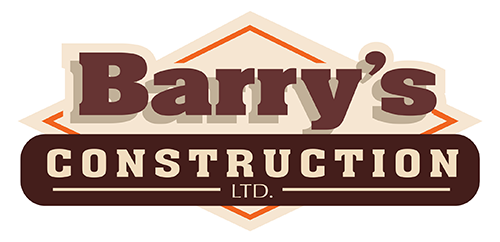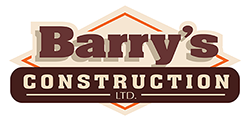At Barry’s Construction, we are dedicated to the highest level of client care. Whether you’re still in the planning stages of your new home, or you’ve already moved in, keep reading for important information about warranties, service reporting, maintenance and more.
Warranty Details
- Requires a home is constructed in a workman-like manner and free from defects in material;
- Protects against unauthorized substitutions
- Requires the home to be fit for habitation;
- Protects against Ontario Building Code violations; and
- Applies for one year, beginning on the home’s date of possession even if the home is sold.
- Protects against water penetration through the basement or foundation walls;
- Protects against defects in materials that affect windows, doors and caulking and defects in work that results in water penetration into the building envelope;
- Covers defects in work or materials in the electrical, plumbing and heating delivery and distribution systems;
- Covers defects in work or materials that result in the detachment, displacement or deterioration of exterior cladding (such as brickwork, aluminum or vinyl siding);
- Protects against violations of the Ontario Building Code that affect health and safety; and
- Applies for two years, beginning on the home’s date of possession.
Your home’s seven-year warranty covers major structural defects (MSD) and begins on the date you take possession of the home and ends on the seventh anniversary of that date. For example, if your home’s date of possession is October 23, 2005, the seven-year MSD warranty begins on October 23, 2005 and remains in effect until and including October 23, 2012.
A major structural defect is defined in the The Ontario New Home Warranties Plan Act as:
In respect of a post June 30, 2012 home, any defect in work or materials in respect of a building, including a crack, distortion or displacement of a structural load-bearing element of the building, if it,
(i) results in failure of a structural load-bearing element of the building,
(ii) materially and adversely affects the ability of a structural load-bearing element of the building to carry, bear and resist applicable structural loads for the usual and ordinary service life of the element, or
(iii) materially and adversely affects the use of a significant portion of the building for usual and ordinary purposes of a residential dwelling and having regard to any specific use provisions set out in the purchase agreement for the home
The seven-year MSD warranty includes significant damage due to soil movement*, major cracks in basement walls, collapse or serious distortion of joints or roof structure and chemical failure of materials. In addition to the general exclusions, the seven-year MSD warranty specifically excludes: dampness not arising from failure of a load-bearing portion of the building; damage to drains or services; and damage to finishes.
Warranties are provided directly through the Tarion Warranty Program. For more information, please see https://www.tarion.com/homeowners/your-warranty-coverage/
Issue Reporting
The table below outlines the warranty forms you can submit to Tarion and when they will be accepted. For your specific form submission deadline dates, refer to your MyHome account or contact Tarion Directly.
| Warranty Form | Warranty Period | Submission Period |
| 30-Day Form | Year 1 | Within 30 days after the date of possession / occupancy |
| Year-End Form | Year 1 | Within the last 30 days before the first anniversary |
| Delayed Closing / Occupancy Form | Year 1 | Any time during the first year of warranty coverage |
| Second-Year Form | Year 2 | Any time during the second year of warranty coverage |
| Major Structural Defect Form | Years 3-7 | Any time during your home's seven years of warranty coverage |
Please note that all issues should be reported to your builder before you report them to Tarion. If you would like to report an issue to Barry’s Construction, please fill out the form at the bottom of this page, or call us directly in case of an emergency at 519-934-3374. We will try our best to facilitate your request as quickly as possible, but we make no guarantees. We will contact you directly to set up an appointment once your request has been processed.
Pre-Delivery Inspection Checklist
Before you move into your new home, you’ll participate in a Pre-Delivery Inspection (PDI) with your builder.
The PDI is your opportunity to learn about how things work and how to properly maintain them. Most importantly, you’ll be able to identify anything that is damaged, missing, or incomplete.
If you’re stressed out about where to begin or what to look out for, worry no more. To help ensure you don’t miss a thing, please visit https://www.tarion.com
This checklist is provided directly by Tarion. For more information, please see https://www.tarion.com/resources/publications/62/pre-delivery-inspection-checklist-new-homes
Moisture Damage
Today’s energy-efficient homes are built tightly to seal out the cold weather in winter and keep in the air conditioning in summer. Because of this, it is possible that a new home can be severely damaged by lack of ventilation or by excess moisture.
It is important to remember that moisture damage caused by improper or inadequate use of your ventilation system, is not covered by the new home warranty.
Your home can be damaged if weather-related water is allowed to enter and remain in the structure. Water from leaking pipes or fixtures that is not immediately cleaned up, and indoor humidity levels that are not properly controlled, can have serious consequences. Sometimes this damage is easily seen, at other times the damage is hidden inside wall and roof spaces. Regardless of where it occurs, moisture damage can lead to serious problems, such as rot, mould, and even structural failure.
Always use your home ventilation system to control moisture. In a typical home, over 20 litres of water are added to the indoor environment every day. That’s 7,300 litres in a year, enough to fill a medium-sized swimming pool. Bathroom fans, kitchen range hoods and packaged ventilators such as heat-recovery ventilators are specifically installed in your home to help you control moisture and contaminants. Regular use of your home ventilation system will exhaust excess airborne moisture caused by bathing, showering, doing laundry and cooking.
Here are some extra tips you can follow to help prevent moisture damage to your home.
Outside the Home
- Keep flowerbeds or landscaping at least six inches or 150 mm away from the top of the foundation. Placing soil near or above the top of the foundation allows moisture to come into direct contact with the structure of the building.
- Ensure that land adjacent to the foundation slopes away from the home so that rainwater and snow melt will run away from the foundation.
- Clear eavestroughs of debris regularly and extend downspouts so that water is directed away from the building. Water flow can erode the ground near the foundation and create depressions where water collects. Standing water near the foundation can force its way into the basement.
- Fix the caulking around windows and doors and on the roof if it becomes cracked or separated.
- Have your roof inspected regularly to ensure shingles, flashing and chimney caps are in place and sealed properly.
Inside the Home
- In the winter, keep the relative humidity in your home in the range of 30-45%. Lower humidity levels may affect your health and cause things made of wood to shrink. Excess humidity can cause condensation on windows and damage the surrounding wall. When using a humidifier, follow the manufacturer’s instructions.
- In the summer, dehumidify the basement to avoid condensation buildup on the cool foundation walls. Relative humidity levels should not exceed 60%.
- Repair leaky pipes and fixtures immediately. Clean and completely dry any areas that are dampened or wet within 48 hours.
- Store organic materials such as newspapers and clothes away from cool, damp areas. Keep storage areas tidy so that air circulates freely.
- Purchase a “hygrometer” to monitor the relative humidity in your home.
- If you are adding a hot tub to your home, or have a large collection of plants, consider the amount of moisture they will add to your indoor air and ventilate accordingly.
- Never vent your clothes dryer inside your home. If you have a gas- or propane-fired dryer you may also be venting carbon monoxide inside your home!
- Investigate and identify any musty smells and odours. They are often an indicator that there is a hidden moisture problem.
Please note that this information was provided directly by Tarion. For more information, please see https://www.tarion.com/homeowners/your-warranty-coverage/maintaining-your-new-home
Seasonal Home Care
If you want your home to stay in pristine condition for years to come, it’s important to plan ahead for preventative maintenance. Small problems can escalate quickly if not attended to right away, so inspect your home regularly for any potential issues. It’s a small investment in time that could save you considerable costs down the line. Keep reading for seasonal checklists that can help you make your own preventative maintenance plan. Or, save yourself the trouble by following Barry’s Construction Home Maintenance Schedule, here:
Barry’s Construction Home Maintenance Schedule
Barry’s Construction Home Maintenance Frequently Asked Questions
Barry’s Construction Service & Warranty Guide – How to Contact Our Service Department
Smoke / CO Detector Information
If you are having issues with your Smoke / CO detectors, please refer to the document below!
March:
- Clean furnace filter and heat recovery ventilator (HRV)
- Check attic
- Check sump pump (if installed)
- Clean humidifier
- Remove snow and ice from overhang and vents
- Check and reset ground fault circuit interrupter (GFCI)
- Test smoke alarms and carbon monoxide detectors
April:
- Check eavestroughs and downspouts
- Clean furnace filter and HRV
- Clean humidifier
- Inspect basement or crawl spaces
- Check roof for loose or cracked shingles
- Check driveways and walks for frost damage
- Check water heater for leaks
- Turn on exterior water supply
- Plan landscaping to avoid soil settlement and water ponding
- Check and reset GFCI
- Test smoke alarms and carbon monoxide detectors
May:
- Inspect fences
- Check caulking for air and water leaks
- Lubricate weather-stripping
- Check exterior finishes
- Check windows and screens are operating properly
- Check septic system (if installed)
- Check and reset GFCI
- Test smoke alarms and carbon monoxide detectors
Please note that all maintenance checklists are provided directly through Tarion. For more information, please see https://www.tarion.com/homeowners/your-warranty-coverage/maintaining-your-new-home
June:
- Inspect air conditioning
- Check roof
- Check sheds and garages
- Check sealing around windows and doors
- Check septic system and clean if necessary
- Fertilize lawn
- Check water heater
- Check and reset ground fault circuit interrupter (GFCI)
- Test smoke alarms and carbon monoxide detectors
July:
- Air out damp basements on dry, sunny day
- Clean air conditioner
- Check exhaust fans
- Check water heater for leaks
- Check and reset GFCI
- Test smoke alarms and carbon monoxide detectors
August:
- Clean air conditioner filter
- Air out damp basements on dry, sunny days
- Inspect driveways and walks
- Inspect doors and locks
- Check and reset GFCI
- Test smoke alarms and carbon monoxide detectors
Please note that all maintenance checklists are provided directly through Tarion. For more information, please see https://www.tarion.com/homeowners/your-warranty-coverage/maintaining-your-new-home
December:
- Check air ducts
- Check for excessive snow on roof
- Clean furnace filter and heat recovery ventilator (HRV)
- Clean humidifier
- Check and reset ground fault circuit interrupter (GFCI)
- Test smoke alarms and carbon monoxide detectors
January:
- Clean furnace filter and HRV
- Check furnace fan belt
- Check water heater
- Check exhaust fans
- Clean humidifier
- Remove snow and ice from roof overhang/vents
- Check and reset GFCI
- Test smoke alarms and carbon monoxide detectors
February:
- Clean furnace filter and HRV
- Check inside surfaces
- Remove snow and ice from roof overhang/vents
- Check and reset GFCI
Please note that all maintenance checklists are provided directly through Tarion. For more information, please see https://www.tarion.com/homeowners/your-warranty-coverage/maintaining-your-new-home
September:
- Check exterior finishes
- Check garage door tracks and lubricate bearings
- Check caulking for air and water leaks
- Plant new lawn
- Check fireplace and chimney
- Check basement or crawl spaces
- Have humidifier, furnace and HRV serviced
- Check clothes dryer vent
- Check and reset ground fault circuit interrupter (GFCI)
- Test smoke alarms and carbon monoxide detectors
October:
- Check windows and screens
- Drain exterior water lines
- Check roof including shingles, flashing and vents
- Check weather-stripping
- Check sealing around windows and doors
- Check septic system
- Winterize landscaping and remove leaves
- Clean furnace filter and HRV
- Clean water heater
- Shut off exterior water supply
- Check eavestroughs and downspouts
- Clean humidifier
- Check and reset GFCI
- Test smoke alarms and carbon monoxide detectors
November:
- Check attic
- Inspect floor drains to ensure trap is filled with water
- Clean furnace filter and HRV
- Check for condensation and humidity
- Check and reset GFCI
- Test smoke alarms and carbon monoxide detectors
Please note that all maintenance checklists are provided directly through Tarion. For more information, please see https://www.tarion.com/homeowners/your-warranty-coverage/maintaining-your-new-home



